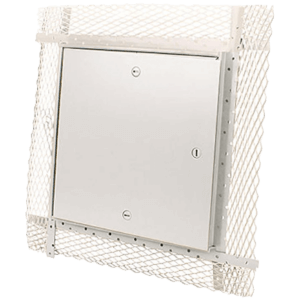
Williams Brothers’ Plaster Bead Access Doors and Panels are designed to provide efficient, secure and concealed service access to critical areas for a wide range of commercial, industrial, institutional and residential applications. Offering a galvanized casing bead and expanded metal lath, our plaster bead doors are an excellent choice for locations where added reinforcement and a clean finish between the door and plaster are desired. Perfect for both new and retrofit building projects, our plaster bead access doors are suitable for use in both walls and ceilings enabling easy access to mechanical, electrical, plumbing and other building systems.
Williams Brothers’ Plaster Bead Access Doors and Panels are available in a wide range of sizes designed to fit common framing dimensions with special sizes and modifications available upon request. Popular sizes include 8×8, 12×12, 14×14, 16×16, 18×18, 24×24, and more. We also offer many additional features such as locks, weather resistive gaskets, choice of finishes and custom color paints.
Williams Brothers prides itself on the differences we bring to our plaster bead access doors. Our dedication to manufacturing quality makes us the choice for construction companies, architects, and engineers that demand the best access doors and panels in the world. Once you see what separates Williams Brothers from other manufacturers, you too will appreciate and demand the Williams Brothers difference.
Metal Door: Our WB PL 500 Series Plaster Bead Access Door is designed for plaster walls and ceiling with the added benefit of a safety edge that gives the door a strong frame while preventing plaster from being chipped during regular use. It comes complete with 14 gauge steel door and 16 gauge steel trim with a galvanized casing bead and lath designed to accommodate 3/4″ of plaster.
Recessed Plaster Door: Our WB AP 510 Series Recessed Plaster Bead Access Door is perfect for an almost completely concealed installation. Door panels are recessed to receive plaster up to 1″ thick. Once installation is complete, only the narrow frame edge can be seen as the door finishes flush with the surrounding field. Surfaces are kept intact visually for a better appearance while also contributing to sound control.